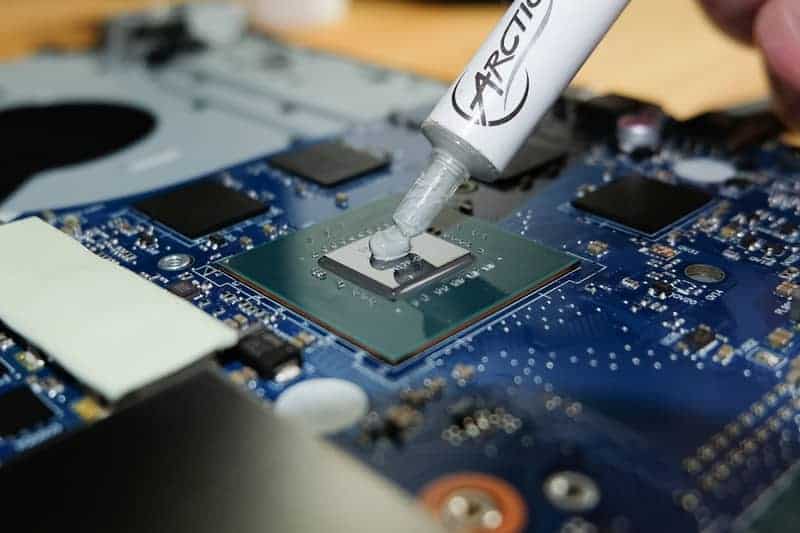Sometimes your laptop may heat for an unexplained reason.
If your heat sink and fans work properly, what else could be the problem?
Most times, you may need to change or replace thermal paste in your laptop to continue using it extensively.
Here’s What You Need To Know About Laptops and Thermal Paste
If all your cooling systems work perfectly but your computer CPU keeps heating, it may be time to change your thermal paste. You can apply it to your processor in one of four ways, using the dot method, the line method, the cross method or spreading.
You need little thermal paste on your CPU. Thermal paste isn’t expensive, with the highest quality topping off at just about $25. In case you need thermal paste but it’s out of reach, try using a diaper rash cream with zinc oxide as a short-term substitute.
Table of Contents

How Do I Know If My Laptop Needs Thermal Paste?
If your computer CPU overheats too often or runs unusually high temperatures, you may have to change your thermal paste. In most cases, your CPU may run hot with no explanation, even though your fan and heat sink work properly.
Your laptop will also need thermal paste any time you remove your CPU cooler from the laptop motherboard. Failing to replace thermal paste upon replacing the CPU cooler will cause overheating. Air bubbles trapped between the CPU cooler and processor will cause poor heat conductivity, which will exacerbate your overheating problems.
You’ll also need to replace your thermal paste every 3 to 5 years, depending on its viscosity. You might take longer before changing thicker thermal paste than thinner, less viscous ones. The pump-out effect causes thinner thermal paste to thin out and eventually causes overheating problems.
What Are The Best Ways To Apply Thermal Paste In a Laptop?
Here are four ways you can apply thermal paste on the CPU or GPU of your laptop:
The Dot Method
This method is the most recommended one for applying thermal paste to your computer. Place a pea-sized drop of thermal paste at the center of the CPU for an even spread when you put the CPU cooler back onto the processor.
This method offers the most efficient solution to your overheating problems
The Line Method
Apply two parallel lines of thermal paste with a thickness of about one-third of the CPU’s width. You can also use a singular line equal to the length of the processor. Ensure that it runs through the center for ideal results.
The Cross/ X Method
Run a thin bead of thermal paste across your CPU from one corner through the center to another. Run this bead again for the opposite side to form an X shape. This method also produces efficient cooling results on your CPU.
The Spread Method
For this method, apply some thermal paste on the surface of your CPU and spread it out to cover the surface using a plastic spatula or your finger covered in plastic. Spreading thermal paste in this way can also have fantastic results in cooling your CPU.
How Many Grams Of Thermal Paste Do I Need?
You need about 0.5g to 1g of thermal paste on a single CPU. For ideal results, ensure you do not exceed this amount or reduce it.
How Long Does Thermal Paste Last In A Laptop?
Quality thermal paste will last you for up to 5 years before replacing it. However, the period you use thermal paste before replacement will vary depending on several factors:
Thermal Paste Quality
The quality, type and ingredients of the thermal paste will determine how long it lasts in use. Heat affects the age of thermal paste and high-quality ones will last you much longer.
Extreme CPU Use
If your laptop runs many heavy computing activities, the lifespan of your paste reduces. Also, overclocking your laptop increases CPU temperatures, which reduces the life of the gel. Consistent overclocking and heavy computing requires constant thermal paste replacement every couple of years.
Environment Of Use
Using your laptop in a cool and clean surrounding will increase the period you can use your thermal paste. Hot temperatures, dirt and dust, on the other hand, will reduce the lifespan of the paste.
Replacing and Repairing Parts
When you decide to change your heat sink, CPU cooler or any other laptop component, you may have to apply new thermal gel. Failing to use thermal paste upon reassembly of your laptop may cause untold damage to your motherboard and other components.
Is There Any Difference Between A Laptop And Desktop Thermal Paste?
There is no difference between laptop and desktop thermal paste. The only thing that will vary is the amount of paste a desktop CPU requires in relation to a laptop CPU.
How Much Does It Cost To Replace Thermal Paste In A Laptop?
It will cost you anywhere between $5 to $25 to purchase new thermal paste for your computer. If you opt to send it to a technician to replace thermal paste, it may cost more. At the $25 range, you’ll get quality thermal paste with premium branding or packaging.
Different thermal paste compounds come with varying ingredients or packaging, with the most expensive thermal pastes being the metallic-based pastes.
If you know how to apply thermal paste to your CPU, then you’ll just have to part with a paltry $25. Otherwise, visit your local electronics store and find out how much they’d charge you to replace thermal paste on your laptop device.
Is Expensive Thermal Paste Worth It?
Expensive thermal paste is worth every single dime you spend buying it. Costlier thermal paste comes with better quality and thermal conductivity. That said, many thermal paste brands will still serve you for years.
Many local stores will offer you a variety of pastes to pick from. Higher-priced pastes will give you a few more years of use over the low-budget pastes.
Which Is The Best Thermal Paste For Laptops?
Over the years, Arctic Silver 5 thermal paste has held a record for being the most efficient option for laptops. It’s metal-based with silver as its base. It ranges from $5 to $8 on most sites.
How Do You Know If Thermal Paste Is Good?
Here are several ways you can use to determine if a thermal paste is fit to use:
Texture and Viscosity
For thermal paste to be useful, it needs to have the right texture and viscosity. A good texture ensures it leaves no air bubbles and spreads uniformly when applied to a CPU.
Besides that, ensure you get paste that isn’t too dense or too light. Perfect viscosity ensures the paste doesn’t spill over to other parts on the motherboard. This consistency also ensures your thermal paste creates good contact between the processor and the heat sink after it sets..
Heat Transfer
Choose a thermal compound with an effective heat transfer rating. Every paste has a different thermal conductivity. Thermal rating shows how efficiently these compounds transfer heat from CPU to the heat sink. A higher thermal conductivity rating is better.
Cooling Solution
No matter the quality of the paste, it must have effective cooling. Choose paste with ingredients that can handle the intense heat levels on your CPU for extended periods. It will last longer, especially on gaming laptops or laptops that routinely perform extensive computing like AI and Machine Learning.
What Is The Best Alternative To Thermal Paste?
One excellent alternative to thermal paste is the Diaper rash cream. Even though it won’t give you much of a lifespan, you can use it as a short-term substitute. Thermal paste substitutes act as immediate remedies to your overheating laptop.
You’ll get days of use out of most thermal paste substitutes before you have to use real thermal paste. Diaper rash cream can get you a few months of use, especially when electronic stores are out of stock or will take longer to deliver.
Diaper rash creams with zinc oxide will also give you better results. Zinc oxide is a common ingredient in almost all thermal compounds.
Another useful alternative is butter, hazelnut spread and some hair gels. However, these substitutes will give you just a few days before they break down.
Is Applying Thermal Paste Worth It?
Applying thermal paste is as necessary as any other repair or service task. You can’t afford not to apply it. Applying thermal paste is essential for new laptops and laptops that develop unexplained heating problems.
Final Thoughts
Every couple of years, replace your thermal paste to keep your CPU running in excellent condition. About $8 should get you good thermal paste you can keep around for such times.
You can use it on both your PC and your laptop and it can save you hundreds of dollars in heat damage. Don’t spill it to other laptop parts, as it may cause short-circuits or destroy components with heat.
Sources
https://www.onecomputerguy.com/thermal-paste-alternative
https://www.newegg.com/insider/thermal-compound-buying-guide/
https://www.intel.com/content/www/us/en/gaming/resources/how-to-apply-thermal-paste.html
